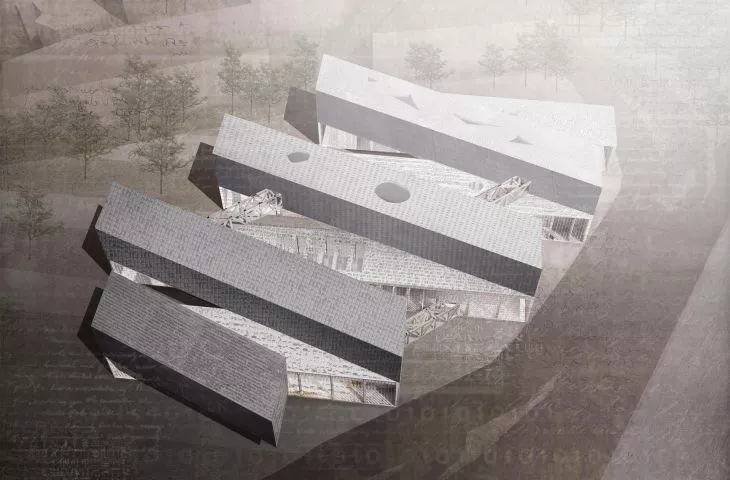The idea for the project was born out of reflection on the history and origin of language. The focus was on functional classification, thus creating a linguistic timeline, which in turn imposed a linear form on the building. Due to the existing context and the shape of the plot, the museum was located in such a way that it was best exposed from the river and the street. In the twist, it was also important to circle the circle of history and close the path of the tour; transparent passages were added to connect each of the bays of the building. This is how the target block was created with a form resembling a serpentine. The name itself is a play on language - it is a combination of the words serpent, referring to the movement of the snake, which is the very way the building is shaped, and time - time, which is the main idea of the project, and the word serpentine, depicting the shape of the building.
location
The museum was located in east London. The entire development is divided into strips that are a continuation of the architecture itself. The main entrance to the building was designed in the western part, visible from the Thames. A parking lot and a theater inscribed in the mass of the Serpentine are also planned on the plot.
landscaping
© Zofia Fedorów
zones
The museum has been divided into zones. The entrance zone was placed in the first bay of the building and is the beginning of the exhibition zone winding through the subsequent elements. In the last, independent bay of the building, the administration and office zone was located. Vertical communication and toilets were placed in the corners of the building, which allowed the creation of additional spaces at level +1 and +3. The auxiliary and technical zone was located at level -1.
cross-section A-A
© Zofia Fedorów
a journey through the history of language
Visitors begin and end their journey through the language museum in the entrance hall, where there is an exhibition on ancient languages. The hall has been finished with wood, with its form referring to an irregular cave. The exhibition is a metaphor for a closed circle of time - from the original language, through its various evolutions, to icons. Then we move on to inanimate languages. This room has been created with glass and architectural archetypes, with the form referring to the respective language groups. It is a space of memories and echoes of ancient languages and cultures. The next exhibit is reborn languages, and here references were made to the Renaissance as synonymous with rebirth through symmetry, geometry and contrast. The fourth room was dedicated to vegetative languages. Steel risers were used as a structure that has functioned for centuries, but is slowly being forgotten.
exhibition of living official languages
© Zofia Fedorów
The fifth exposition is the living official languages. The aim of the exhibition was to create a dynamic space using mirror bevels and the phenomenon of reflection. A room of unofficial living languages was also planned, that is, other forms of language used today, such as the Internet language or icons. Rubber was used here to create an organic and flexible space. The final exhibit is Languages of the Future - emerging forms of languages, including programming. The space is a metaphor for conceptualism, the main direction in contemporary art, in which the essence is thought, an intangible form. It was decided to leave the space empty, so that the exhibition is created by the concept itself, with the help of light and steam.
facades
The facades are decorated with fragments of texts in languages from around the world. To emphasize the serpentine shape, a gradation of shades was used in the upper part of the facade panels and in the lower part of the milky glass gradually reducing transparency.
language of architecture
west elevation
© Zofia Fedorów
The project is a kind of confrontation of architectural language with other forms of languages, a comparison of the evolution of language and architecture and contemporary art. It seeks to show these transformations through the building itself.
Zofia FEDORÓW
© Author



















































































